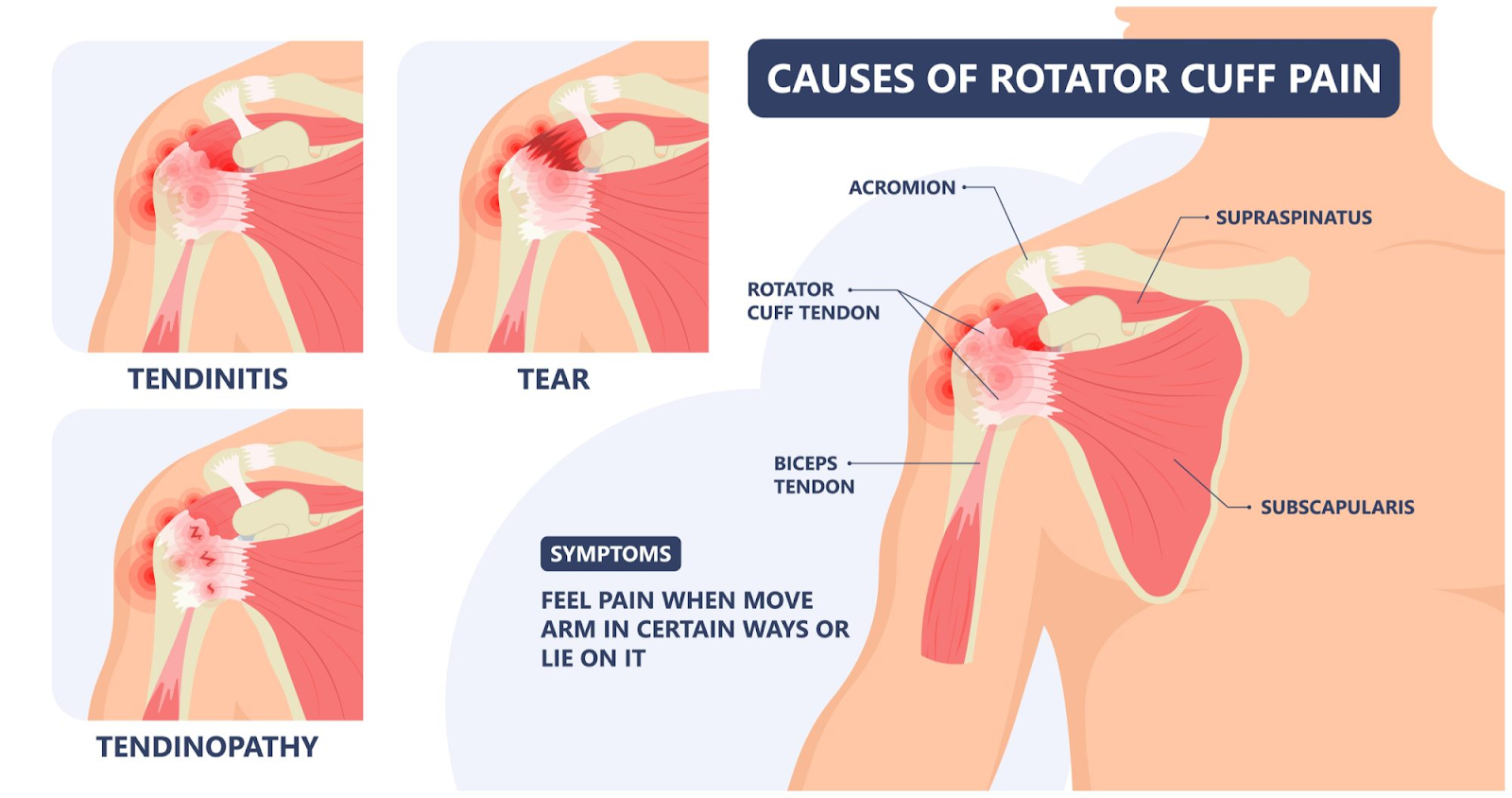Rotator cuff tendinitis is a common shoulder condition that can cause discomfort, pain, and limited mobility. Whether you're an athlete, a painter, or someone who engages in repetitive shoulder movements, understanding the causes, symptoms, and treatment options for rotator cuff tendinitis is essential for proper management and recovery.
1. What is Rotator Cuff Tendinitis?
Rotator cuff tendinitis, also known as shoulder impingement syndrome, is a condition characterized by inflammation or irritation of the tendons in the rotator cuff of the shoulder. The rotator cuff is a group of muscles and tendons that surround the shoulder joint, providing stability and enabling various movements, such as lifting and rotating the arm.
When the tendons of the rotator cuff become inflamed or irritated, it can cause pain and discomfort in the shoulder. This inflammation is often a result of repetitive or excessive use of the shoulder, leading to micro-traumas or small tears in the tendons. Over time, these repetitive stresses and minor injuries can lead to chronic inflammation and the development of rotator cuff tendinitis.
2. Causes of Rotator Cuff Tendinitis:
Overuse and repetitive motions: Understanding how repetitive activities can strain the tendons
Aging and degenerative changes: Exploring how age-related factors can contribute to the development of tendinitis
Injury and trauma: Discussing how sudden injuries or accidents can lead to rotator cuff tendinitis
3. Common Symptoms of Rotator Cuff Tendinitis:
Shoulder pain: Identifying the location and characteristics of the pain
Limited range of motion: Exploring how tendinitis can restrict movement in the shoulder joint
Weakness and instability: Understanding the impact of tendinitis on shoulder strength and stability
4. Diagnosing Rotator Cuff Tendinitis:
- Physical examination: Discussing the methods used by healthcare professionals to evaluate the shoulder
- Imaging tests: Exploring the role of X-rays, ultrasounds, and MRIs in diagnosing rotator cuff tendinitis
5. Effective Treatment Strategies:
- Rest and activity modification: Understanding the importance of giving the shoulder proper rest and avoiding aggravating activities
- Medications: Exploring over-the-counter pain relievers and anti-inflammatory drugs for symptom relief
- Physical therapy: Highlighting the role of specific exercises in strengthening the shoulder muscles and improving flexibility
- Surgical intervention: Exploring cases where surgery may be necessary to repair the damaged tendons
6. Preventing Rotator Cuff Tendinitis:
- Ergonomics and proper technique: Providing tips for maintaining good posture and using correct body mechanics during physical activities
- Gradual progression and warm-up exercises: Emphasizing the importance of gradually increasing intensity and incorporating warm-up exercises before engaging in strenuous activities
- Strengthening exercises: Suggesting exercises that target the rotator cuff muscles to improve strength and stability
7.Do's & Don'ts:
When dealing with rotator cuff tendinitis, there are certain dos and don'ts that can help manage the condition and prevent further injury. Here are some guidelines to follow:
Dos:
1. Do rest your shoulder: Give your shoulder adequate rest to allow the tendons to heal. Avoid activities that cause pain or worsen the symptoms.
2. Do apply ice packs: Apply ice packs to your shoulder for 15-20 minutes at a time, several times a day. This can help reduce pain and inflammation.
3. Do gentle stretching exercises: Perform gentle stretching exercises recommended by a physical therapist or healthcare professional to improve flexibility and maintain range of motion in your shoulder.
4. Do strengthen the surrounding muscles: Engage in exercises that target the muscles around the shoulder joint, as strengthening them can provide support and stability to the area.
5. Do maintain good posture: Maintain proper posture to avoid unnecessary strain on your shoulders. Sit and stand up straight, keeping your shoulders relaxed and aligned.
6. Do use proper lifting techniques: When lifting objects, use your legs instead of your shoulders and avoid lifting heavy items that exceed your capacity.
7. Do consult a healthcare professional: If the pain persists or worsens, it's important to consult a healthcare professional for a proper diagnosis and appropriate treatment plan.
Don'ts:
1. Don't ignore the pain: Ignoring the pain and continuing with activities that aggravate your symptoms can lead to further damage. Listen to your body and avoid activities that cause pain.
2. Don't overdo physical activities: Avoid excessive or repetitive shoulder movements that can strain the tendons and worsen the condition. Take breaks and pace yourself during physical activities.
3. Don't perform heavy lifting: Refrain from lifting heavy objects, especially if it causes pain or discomfort in your shoulder.
4. Don't rely solely on medication: While over-the-counter pain relievers can provide temporary relief, it's important not to rely solely on medication. Address the root cause of the problem through rest, exercises, and other recommended treatments.
5. Don't slouch or hunch over: Poor posture can strain your shoulder and worsen the symptoms. Avoid slouching or hunching over and maintain good posture throughout the day.
6. Don't push through the pain: Pushing through the pain can lead to further injury and delay the healing process. Respect your body's limits and give it the time it needs to heal.
7. Don't delay seeking professional help: If your symptoms are severe, persist for an extended period, or significantly impact your daily activities, don't hesitate to seek medical advice. A healthcare professional can provide a proper diagnosis and guide you on the appropriate treatment options.
Rotator cuff tendinitis can significantly impact daily life and hinder shoulder function. By understanding its causes, recognizing the symptoms, and implementing appropriate treatment strategies, individuals can effectively manage and recover from this condition. Whether through rest, physical therapy, or, in severe cases, surgical intervention, it is possible to alleviate pain, improve shoulder mobility, and prevent further complications. Remember, early intervention and proper care are crucial for a successful recovery and long-term shoulder health.
Remember, every individual's condition may vary, so it's important to consult with a healthcare professional for personalized advice and guidance on managing rotator cuff tendinitis.
FOR MORE DETAILS,CONSULT NOW









.png)

Comments
Post a Comment